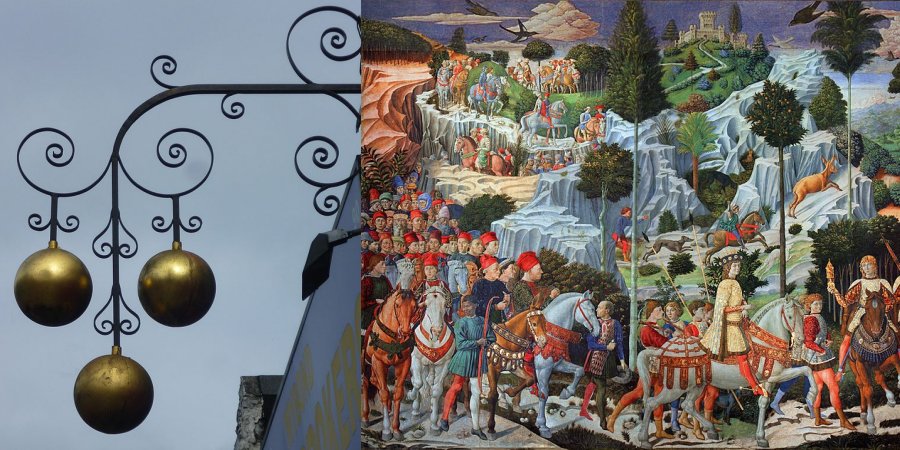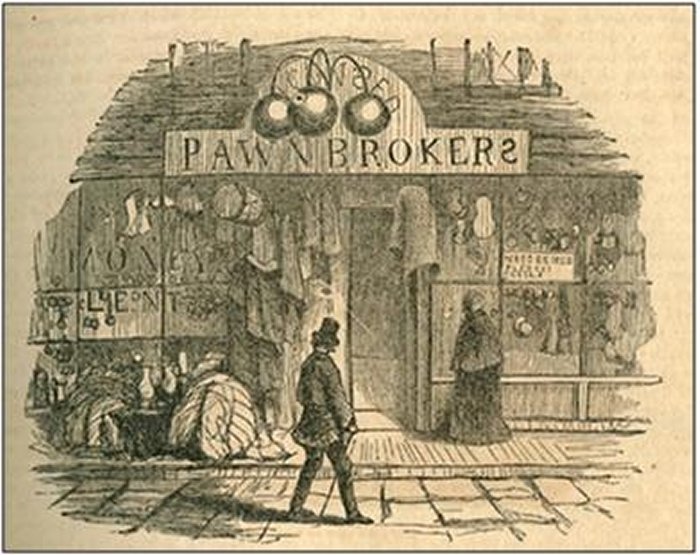Why Is The Three Golden Balls Symbol For A Pawn Shop Connected To The Medici Family?
Conny Waters - AncientPages.com - The need for fast cash is not new. Our ancestors realized it long ago and came up with the idea of pawnbroking.
Money has always played a central role in people's lives, regardless of whether payment has been rare shells, worthless iron coins, small springs, or stamped precious metal pieces.
Left: A London shop displays the traditional pawnbroker's sign. Credit: Kim Traynor, Wikipedia, CC BY-SA 3.0
Right: Medici family members placed allegorically in the entourage of a king from the Three Wise Men in the Tuscan countryside in a Benozzo Gozzoli fresco, c. 1459. Credit: Public Domain
This topic is covered in our comprehensive article “our lives have always been manipulated by money”. The origin of money is hidden in the distant past, but for the first time, money is mentioned in writing in Mesopotamia (today: Iraq).
The history of banks can be traced to ancient Babylonian temples in the early 2nd millennium BC. In Babylon, there are records of loans made by the temple priests at the time of Hammurabi. Temples took in donations and tax revenue and amassed great wealth. Then, they redistributed these goods to people in need, such as widows, orphans, and the poor.
It should not come as a surprise to learn that the history of pawnbroking also goes far back in time. The first pawn shops emerged 3,000 years ago in ancient China when peasants quickly needed money. So, they visited a pawn shop that offered them short-term credit. This ancient business idea spread to ancient Greece and Rome, where similar pawnshops were established. During the Middle Ages, the Catholic Church stopped the growth of pawn shops because charging interest on loans was not correct in the eyes of the Christians.
But this didn’t stop the pawn brokers who spread and arrived in England with William the Conqueror.
Knight Templars who needed money to finance their equipment and transport to the Holy land often brokered their land holdings to monasteries that supplied the necessary funds.
This important way of financing business continued to thrive and has survived until modern days.
If you have visited or passed a pawn shop, you may have noticed the three golden balls suspended from a bar. These three spheres are the pawnbrokers' symbol, and their history can be traced to the powerful Medici family.
As mentioned earlier on Ancient Pages, the Medici family were Renaissance Godfathers. They were bankers, and they had “access to untold resources which they used to obtain civic power over the city of Florence. As history tells us, they were not the only famous or powerful family of the Renaissance era, but they lasted the longest and ruled Florence for roughly 250 years.”
But what is the connection between the pawn shop’s three golden balls and the Medici family?
The answer is quite simple. “The three golden balls were originally the symbol of the Medici family of Florence, who were the owners of many pawnshops in Italy during the Middle Ages.
According to legend, Averado de Medici, while serving under Charlemagne, once slew a giant warrior named Mugello on whose mace were three golden balls. Averado adopted these bails to commemorate his victory as a device on the Medici family coat of arms. Later, the balls were displayed over the entrances of the de Medici pawnshops and eventually came to symbolize pawnshops in general.” (Smith, Douglas B.. Ever Wonder Why?)
Credit: American Enterprise Education
This is also why most European towns called the pawn shop the "Lombard."
It’s a bit ironic that the Christian Church prohibited pawnbroking, yet Saint Nicholas later became the patron saint of pawnbrokers.
The symbol is associated with Saint Nicholas because he was kind enough to give a poor man's three daughters each a bag of gold so they could get married.
Updated on January 21, 2024
Written by Conny Waters – AncientPages.com Staff Writer
Copyright © AncientPages.com All rights reserved. This material may not be published, broadcast, rewritten or redistributed in whole or part without the express written permission of AncientPages.com
Expand for referencesSmith, Douglas B. - Ever Wonder Why?
More From Ancient Pages
-
 Myths And Legends Reveal Ancient Turtle Worship Linked To The Creation Of The World
Featured Stories | Jun 24, 2020
Myths And Legends Reveal Ancient Turtle Worship Linked To The Creation Of The World
Featured Stories | Jun 24, 2020 -
 Obscure History Of Skara Brae – Home To Dwarfs
Featured Stories | Apr 12, 2017
Obscure History Of Skara Brae – Home To Dwarfs
Featured Stories | Apr 12, 2017 -
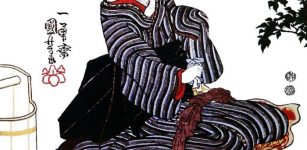 Jigai – Suicide Ritual For Wives Of Samurai – Feminine Counterpart Of Seppuku
Ancient History Facts | Feb 24, 2018
Jigai – Suicide Ritual For Wives Of Samurai – Feminine Counterpart Of Seppuku
Ancient History Facts | Feb 24, 2018 -
 Magical Adder Stone And Its Immense Power
Celtic Mythology | Jul 14, 2018
Magical Adder Stone And Its Immense Power
Celtic Mythology | Jul 14, 2018 -
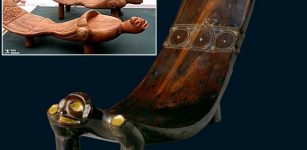 Curious Ritual Wooden ‘Duho’ Stool Of Ancient Taino People
Ancient Traditions And Customs | Sep 12, 2017
Curious Ritual Wooden ‘Duho’ Stool Of Ancient Taino People
Ancient Traditions And Customs | Sep 12, 2017 -
 Three Unusual Celestial Journeys And The Chosen Ones Initiated Into The Secrets Of The Gods
Ancient Mysteries | Jul 26, 2021
Three Unusual Celestial Journeys And The Chosen Ones Initiated Into The Secrets Of The Gods
Ancient Mysteries | Jul 26, 2021 -
 Kava – Astonishing Ancient Plant That Improves Emotional Intelligence Is Gaining Popularity In The Western World
Featured Stories | Mar 31, 2018
Kava – Astonishing Ancient Plant That Improves Emotional Intelligence Is Gaining Popularity In The Western World
Featured Stories | Mar 31, 2018 -
 Barabar Caves: The Oldest Surviving Rock-Cut Caves With Acoustic Effects In India
Featured Stories | Jul 1, 2021
Barabar Caves: The Oldest Surviving Rock-Cut Caves With Acoustic Effects In India
Featured Stories | Jul 1, 2021 -
 Triumphal Arch Of Roman Emperor Constantine And His Great Vision
Featured Stories | Jul 12, 2017
Triumphal Arch Of Roman Emperor Constantine And His Great Vision
Featured Stories | Jul 12, 2017 -
 Ancient History Of Chinese Swords
Featured Stories | Aug 20, 2018
Ancient History Of Chinese Swords
Featured Stories | Aug 20, 2018 -
 Quest For The Magical Healing Flower In The Garden Of Bakavali Led To A Love Story
Featured Stories | May 28, 2019
Quest For The Magical Healing Flower In The Garden Of Bakavali Led To A Love Story
Featured Stories | May 28, 2019 -
 Medici Family – Powerful Renaissance Godfathers And Patrons Of Galileo Galilei
Featured Stories | Dec 17, 2018
Medici Family – Powerful Renaissance Godfathers And Patrons Of Galileo Galilei
Featured Stories | Dec 17, 2018 -
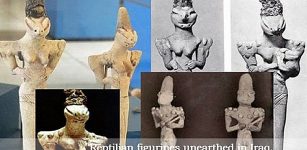 The Mystery Of The Serpent Seed
Biblical Mysteries | Jul 19, 2019
The Mystery Of The Serpent Seed
Biblical Mysteries | Jul 19, 2019 -
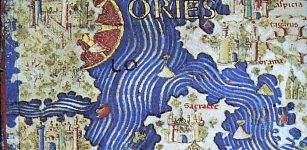 Fra Mauro Medieval Map: Accurate And Detailed Work Attesting To Advanced Geographic Knowledge Of Contemporary Cartographers
Artifacts | Feb 8, 2019
Fra Mauro Medieval Map: Accurate And Detailed Work Attesting To Advanced Geographic Knowledge Of Contemporary Cartographers
Artifacts | Feb 8, 2019 -
 Are The Strange Lawrence Brook Carvings In New Jersey A Cryptic Message?
Featured Stories | Feb 10, 2023
Are The Strange Lawrence Brook Carvings In New Jersey A Cryptic Message?
Featured Stories | Feb 10, 2023 -
 Fascinating Discovery Of An Inhabited Underground World In Medieval Wales
Featured Stories | Mar 2, 2024
Fascinating Discovery Of An Inhabited Underground World In Medieval Wales
Featured Stories | Mar 2, 2024 -
 Secret Encounter With A Mysterious ‘Out-Of-Place’ Lost Tribe In The Amazon Jungle – Did They Possess Strange Mental Powers?
Featured Stories | Jan 16, 2025
Secret Encounter With A Mysterious ‘Out-Of-Place’ Lost Tribe In The Amazon Jungle – Did They Possess Strange Mental Powers?
Featured Stories | Jan 16, 2025 -
 Is There An Ancient Secret Connection Between The Statue Of Liberty And The Anunnaki Goddess Inanna?
Featured Stories | Sep 28, 2018
Is There An Ancient Secret Connection Between The Statue Of Liberty And The Anunnaki Goddess Inanna?
Featured Stories | Sep 28, 2018 -
 Vikings: Facts And History About The Tough Norse Seafaring People
Ancient History Facts | Mar 13, 2017
Vikings: Facts And History About The Tough Norse Seafaring People
Ancient History Facts | Mar 13, 2017 -
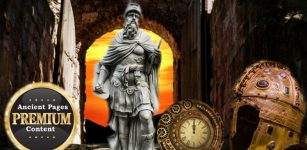 Unexplained Phenomenon In East Anglia – Ancient Mystery Deepens As More Unusual Sightings Are Reported – Part 2
Ancient Mysteries | Jun 1, 2018
Unexplained Phenomenon In East Anglia – Ancient Mystery Deepens As More Unusual Sightings Are Reported – Part 2
Ancient Mysteries | Jun 1, 2018

